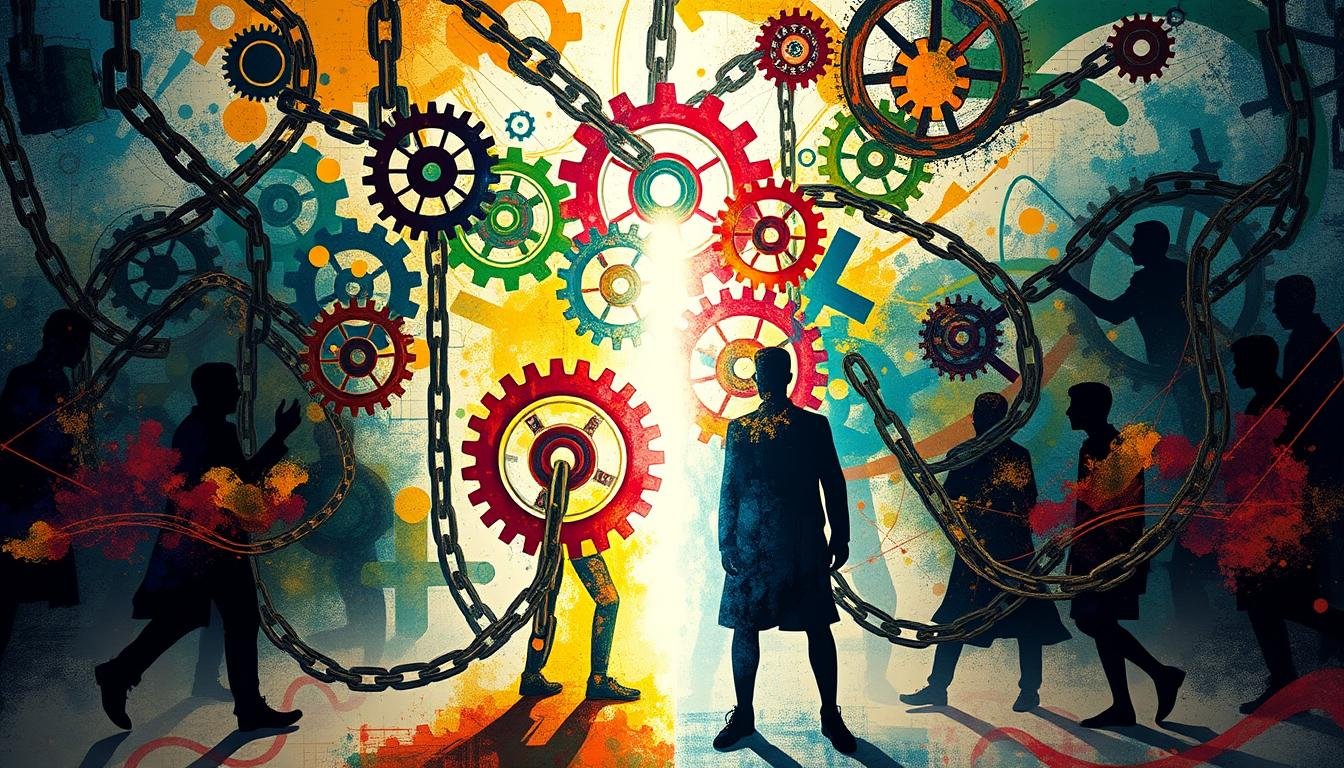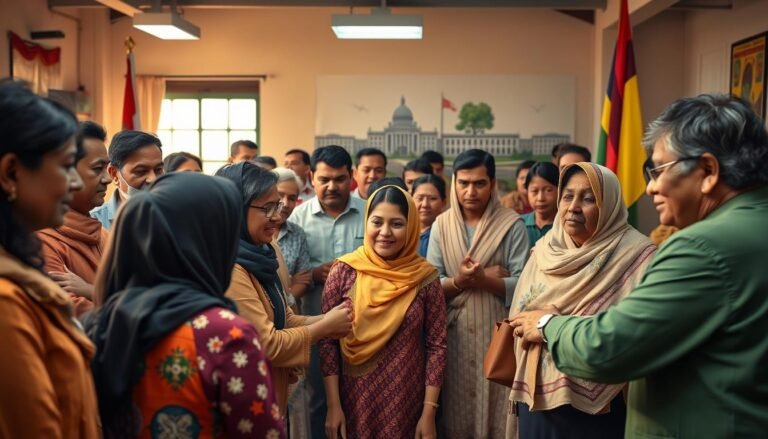Sociological Theories of Power: An Overview
Ever thought about who really has the power in our society? Sociologists have been exploring this question for years. They’ve come up with different theories to explain power and social order. These theories range from Marx’s class-based ideas to modern feminist views, giving us deep insights into power’s role in our lives.
Power comes from the Latin word ‘potere’, meaning ‘to be able’. It’s the ability to get what you want, even if others don’t agree. Max Weber, a key thinker, saw power as a way to overcome obstacles and achieve goals. This overview will cover main sociological theories of power, showing how power is spread and used in society.
These theories include class, elite, pluralist, and gender perspectives. They help us understand conflict and social dynamics. By looking at these theories, we can see how power affects people and groups.
Key Takeaways
- Power in sociology is the ability to achieve goals despite opposition
- Major theories include class, elite, pluralist, and gender perspectives
- These theories offer diverse explanations for power distribution
- Understanding power dynamics is crucial for analyzing social stratification
- Sociological theories of power continue to evolve with society
Introduction to Power in Sociology
Power affects our lives in many ways, from our personal relationships to global politics. It shapes how we interact and make decisions. In sociology, power is a key concept that helps us understand social structures and dynamics.
Definition of Power
Max Weber, a famous sociologist, defined power as the ability to achieve goals even when others oppose you. This idea shows how power impacts our daily lives and society.
Importance of Power in Social Dynamics
Power is vital in social stratification. It decides who gets resources and makes important choices. For example, during the Arab Spring, social media gave protesters a new form of power. They used it to share information and gain global support for their cause.
Overview of Major Theories
Sociologists have developed several theories to explain power dynamics:
- Class Theory: Karl Marx believed society is split between the rich and the poor.
- Elite Theory: This view says a small group of elites holds most of the power.
- Pluralist Theory: It argues that power is spread among different competing groups.
- Gender Theory: This perspective focuses on how men often dominate women in society.
| Theory | Key Idea | Example |
|---|---|---|
| Class Theory | Rich vs. Poor divide | Wealth inequality |
| Elite Theory | Small group dominance | Corporate influence |
| Pluralist Theory | Dispersed power | Interest group politics |
| Gender Theory | Male dominance | Workplace discrimination |
These theories help us analyze power in different contexts, from personal relationships to global politics. By understanding these concepts, we can better grasp how power shapes our society and influences social change.
Class Theory of Power
Class theory of power looks at how being rich or poor affects society. It shows how wealth can lead to more power over resources and decisions. This idea comes from Marxist theory.
Marxist Perspective on Power
Marxist theory says society has two main groups: the rich who own production means and the working class who sell their labor. This gap creates power differences, with the rich having more control over society.
Rich vs. Poor Class Dynamics
Conflict theory looks at the fight between these two groups. A small group, about 1% of the population, holds over half of the wealth, as shown in a 2010 study. This wealth lets them control society for their benefit.
Economic Dominance and Social Control
Being economically powerful means having control over society. The rich use money to influence policy through donations and lobbying. For example, in 2009, the oil and gas industry spent a lot on lobbying.
This shows how big companies can make laws that help them. The U.S. has weak pollution laws, showing how this works.
“The ruling class in the United States is composed of the richest 0.5% to 1% of the population, who control over half of the nation’s wealth.” – G. William Domhoff
Class theory of power helps us see how economic differences shape society and decisions. It shows why Marxist ideas are still important for understanding power today.
Elite Theory of Power
A small group of people, called the power elite, has a big impact on society. Scholars believe these elites are set apart by their wealth, knowledge, or status. They use these qualities to make decisions and set rules, even in democracies.
Vilfredo Pareto saw elites as having better minds and skills. Gaetano Mosca pointed out that elites are a structured minority, unlike the masses. Robert Michels said that all groups, even organizations, follow elitist leadership rules.
C. Wright Mills talked about a three-part power structure in the US, with leaders in politics, economy, and military. His idea showed how power gets concentrated in modern societies. G. William Domhoff looked into who really runs America, finding that an elite group controls both the economy and politics.
| Theorist | Key Concept | Contribution to Elite Theory |
|---|---|---|
| Vilfredo Pareto | Governing and Non-Governing Elites | Identified superior abilities of elites |
| Gaetano Mosca | Organized Minority vs. Unorganized Majority | Emphasized elite superiority and organization |
| Robert Michels | Iron Law of Oligarchy | All organizations operate through elitist principles |
| C. Wright Mills | Triumvirate Power Structure | Highlighted power consolidation in industrial societies |
| G. William Domhoff | Elite Control of Power Structure | Investigated elite control of economic and political power |
The elite theory questions the idea of democracy and shows how social class affects power. It helps us see how a few people can greatly influence society’s decisions.
Pluralist Theory: A Functionalist Perspective
Pluralist theory looks at power in democratic societies from a unique angle. It believes power is spread across different groups. These groups compete for resources and influence.
Concept of Veto Groups
Veto groups are key to pluralist theory. They can stop or change political decisions. Examples include labor unions, business groups, and advocacy groups. These groups help shape policies and keep power balanced.
Government as a Neutral Referee
The government in this view is like a referee. It doesn’t take sides but helps groups compete fairly. This is different from theories that say the government helps certain classes or elites.
Functional Aspects of Group Competition
Competition among groups has many benefits, say pluralists. It turns conflicts into political debates. It lets groups reach their goals and makes sure society benefits overall. This competition keeps society stable and moving forward.
| Aspect | Function |
|---|---|
| Veto Groups | Balance power, influence decisions |
| Government Role | Neutral mediator |
| Group Competition | Channel conflicts, achieve goals |
The pluralist theory shows how diverse groups and balanced power shape politics. It stresses the role of competition and negotiation in society.
Gender Theory of Power
Gender theory of power looks at how society keeps men in charge. It’s based on feminist ideas and fights for equal rights in all areas of life. This means men and women should have the same power in society, work, and politics.
Patriarchal Dominance in Society
For a long time, men have held more power than women. This is seen in many parts of life, like at work and in politics. Women working full-time make about 80.5 cents for every dollar men earn. This shows there’s still a big gap in pay between men and women.
Feminist Critiques of Power Structures
Feminist thinkers say that society’s norms and values keep women unequal. Adkins looked into this in 2015, showing how economic policies hurt women more. Allen’s 2016 study found that women face power imbalances even at home.
Advocacy for Gender Equality in Power Distribution
More people are now pushing for women to have equal power. They want more women in leadership, fair pay, and to change old beliefs. Eyal-Lubling and Krumer-Nevo’s 2016 study showed how important it is to bring gender equality into work.
| Aspect | Current State | Goal |
|---|---|---|
| Wage Gap | 19.5% | 0% |
| Political Representation | Underrepresented | Equal Representation |
| Leadership Roles | Male-dominated | Gender Balance |
By fixing these issues, we can make society more fair for everyone. This will help all genders and make progress more inclusive.
Sociological Theories of Power: An Overview
Power shapes our social world. Sociologists study how power works through different theories. These ideas help us get why some people are more powerful than others and why conflicts happen.
Marx believed power goes to those who own the means of making things. He said the rich use their money power to look out for themselves. This view shows how class struggle is a big part of our social lives.
Weber built on Marx’s ideas. He said power is the ability to get what you want even when others don’t want you to. Weber looked at class, status, and party as ways people get power. This gives us a deeper look at social layers.
Foucault offered a fresh view on power. He thought power spreads out across society, not just being in one place. Foucault said power shapes what we know and makes us who we are. His ideas started a new way of thinking about power.
“Power is everywhere and comes from everywhere.”
These theories give us deep insights into power in society. They help us see how social structures, unfairness, and conflicts work. By understanding these views, we can see the complex power relationships that affect our lives every day.
Power Elite Theory by C. Wright Mills
C. Wright Mills’ power elite theory shows how a few people control America. They make big decisions that shape the country’s future.
Composition of the Power Elite
The power elite includes leaders from government, big business, and the military. These groups have a lot of power over America’s resources and decisions.
- Less than 250 individuals occupy top positions in federal government branches
- About 200 people run major television networks and national newspaper chains
- Top corporate leaders control half of the nation’s industrial, communications, and banking assets
Interlocking Directorates
The power elite theory talks about how leaders in different sectors are connected. This network helps them keep control and influence over society.
| Sector | Interconnection |
|---|---|
| Corporate | 341 directorships in 112 corporations |
| Education | 54% of top corporate leaders from 12 private colleges |
| Political | 42% of highest political officials from same 12 colleges |
Circulation of Elites
The power elite theory also looks at how people move between sectors. This movement helps them keep their grip on American life. The theory says power in the U.S. has changed over time, with different groups in charge at different times.
“The power elite is composed of men whose positions enable them to transcend the ordinary environments of ordinary men and women; they are in positions to make decisions having major consequences.”
Critical Evaluation of Power Theories
Power theories in sociology give us different ways to look at how society works. Critical theory and postcolonial theory help us see the power structures. They question old ideas and show the complexity of power in society.
Structural functionalism sees society as a system where everything works together. Robert Merton’s idea of manifest and latent functions adds more to this view. But, this theory has trouble explaining how society changes.
Conflict theory, based on Karl Marx’s ideas, sees society as a fight for resources. This view highlights class struggles and power differences. Weber’s idea that power is the ability to do what you want even when others resist is still important.
Postcolonial theory looks at power in a global setting. It shows how history affects power today. This theory is key for understanding global relations and cultural impacts.
“Power is not a means, it is an end.” – George Orwell
Each theory has its good points and weaknesses. Real power struggles often mix different theories in complex ways. To really get how power works, we need to look at various views and how society changes.
Conclusion
Sociological theories of power give us deep insights into how society is structured and how conflicts arise. Max Weber and Talcott Parsons are key thinkers in this area. They show us the different kinds of power and how they keep society stable.
Today, their ideas are more important than ever. With digital technology, new kinds of authority have emerged. This fits with Weber’s and Parsons’ theories. We see this in how inequality and social movements challenge our power structures.
In America, power is shown in many ways. Big companies, banks, and experts have a lot of influence. The top class uses nonprofits to shape policy. Even though some say they have no power, the wealthy and big leaders often make the rules.
These theories give us a deep look at power’s many sides. They cover structural, cultural, and intersectional aspects of power. By grasping these ideas, we can better see and tackle the complex power issues in our society.
Source Links
- The Main Sociological Theories | Introduction to Sociology
- Major Sociological Theories
- Abhipedia
- Sociological Theories of Power
- Power and Authority
- Power: An Introduction
- Theories of Power and Society
- 14.3 Theories of Power and Society
- Elite theory
- Elite theory | Political Science & Power Structures
- Microsoft Word – papt1.doc
- Theoretical Perspectives on Government and Power
- 17.4 Theoretical Perspectives on Government and Power
- LibGuides: Social Work Theories: Feminist Theory (Jan 2018)
- Theoretical Perspectives on Gender | Introduction to Sociology
- Feminist Perspectives on Power
- Sociological Theories of Power – UPSC Notes » LotusArise
- Microsoft Word – power_after_lukes.doc
- The Power Elite
- C. Wright Mills, Power Structure Research, and the Failures of Mainstream Political Science
- The Power Elite by C. Wright Mills 1956
- 1.3 Theoretical Perspectives in Sociology – Introduction to Sociology 3e | OpenStax
- empowerment.indd
- Theories of power and social change. Power contestations and their implications for research on soci
- Max Weber and Talcott Parsons: Defining Power in Sociological Theory • Sociology Institute
- The Class-Domination Theory of Power
- Sociological Theories of Power







